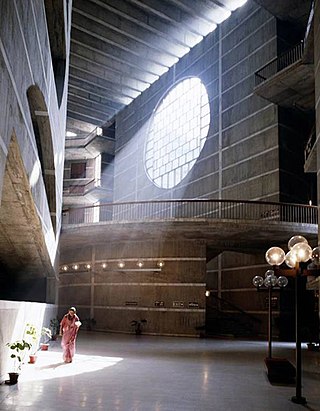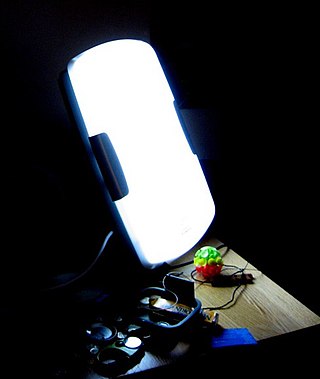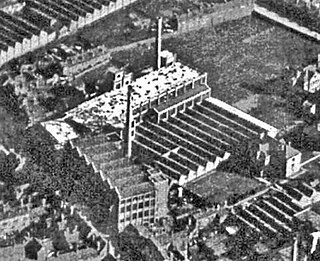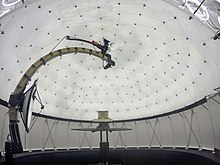
Light pollution is the presence of unwanted, inappropriate, or excessive artificial lighting. In a descriptive sense, the term light pollution refers to the effects of any poorly implemented lighting, during the day or night. Light pollution can be understood not only as a phenomenon resulting from a specific source or kind of pollution, but also as a contributor to the wider, collective impact of various sources of pollution.

Daylighting is the practice of placing windows, skylights, other openings, and reflective surfaces so that direct or indirect sunlight can provide effective internal lighting. Particular attention is given to daylighting while designing a building when the aim is to maximize visual comfort or to reduce energy use. Energy savings can be achieved from the reduced use of artificial (electric) lighting or from passive solar heating. Artificial lighting energy use can be reduced by simply installing fewer electric lights where daylight is present or by automatically dimming or switching off electric lights in response to the presence of daylight – a process known as daylight harvesting.

Lighting or illumination is the deliberate use of light to achieve practical or aesthetic effects. Lighting includes the use of both artificial light sources like lamps and light fixtures, as well as natural illumination by capturing daylight. Daylighting is sometimes used as the main source of light during daytime in buildings. This can save energy in place of using artificial lighting, which represents a major component of energy consumption in buildings. Proper lighting can enhance task performance, improve the appearance of an area, or have positive psychological effects on occupants.

The sky is an unobstructed view upward from the surface of the Earth. It includes the atmosphere and outer space. It may also be considered a place between the ground and outer space, thus distinct from outer space.

Computer simulation is the process of mathematical modelling, performed on a computer, which is designed to predict the behaviour of, or the outcome of, a real-world or physical system. The reliability of some mathematical models can be determined by comparing their results to the real-world outcomes they aim to predict. Computer simulations have become a useful tool for the mathematical modeling of many natural systems in physics, astrophysics, climatology, chemistry, biology and manufacturing, as well as human systems in economics, psychology, social science, health care and engineering. Simulation of a system is represented as the running of the system's model. It can be used to explore and gain new insights into new technology and to estimate the performance of systems too complex for analytical solutions.

A heliodon (HEE-leo-don) is a device for adjusting the angle between a flat surface and a beam of light to match the angle between a horizontal plane at a specific latitude and the solar beam. Heliodons are used primarily by architects and students of architecture. By placing a model building on the heliodon’s flat surface and making adjustments to the light/surface angle, the investigator can see how the building would look in the three-dimensional solar beam at various dates and times of day.

Architectural lighting design is a field of work or study that is concerned with the design of lighting systems within the built environment, both interior and exterior. It can include manipulation and design of both daylight and electric light or both, to serve human needs.

Artificial sunlight is the use of a light source to simulate sunlight where the unique characteristics of sunlight are needed, but where sufficient natural sunlight is unavailable or infeasible. A device used to simulate sunlight is a solar simulator.

Light tubes are structures that transmit or distribute natural or artificial light for the purpose of illumination and are examples of optical waveguides.

Glare is difficulty of seeing in the presence of bright light such as direct or reflected sunlight or artificial light such as car headlamps at night. Because of this, some cars include mirrors with automatic anti-glare functions and in buildings, blinds or louvers are often used to protect occupants. Glare is caused by a significant ratio of luminance between the task and the glare source. Factors such as the angle between the task and the glare source and eye adaptation have significant impacts on the experience of glare.

Anidolic lighting systems use anidolic optical components to light rooms. Light redirected by these systems does not converge to a focal point or form an image, hence the name.

Sustainable lighting is lighting designed with energy efficient light sources. "There are simple design strategies and some materials that can facilitate the energy saving advantages of natural light. Light colored interiors and open floor plans are good choices. This approach also augments artificial light efficiency. Energy efficient lighting is not simply finding the most light for the least wattage or the longest lasting light bulb. Proper sizing of the light to the needs of the location and the tasks that will be performed, called task lighting, is an energy saving strategy."
North light is sunlight coming through a north-facing window. Because it does not come directly from the sun, it remains at a consistent angle and colour throughout the day and does not create sharp shadows. It is also cooler than direct sunlight due to the way the Earth's atmosphere scatters light via Rayleigh scattering.

In architecture, a daylight factor (DF) is the ratio of the light level inside a structure to the light level outside the structure. It is defined as:

A saw-tooth roof is a roof comprising a series of ridges with dual pitches either side. The steeper surfaces are glazed to admit daylight and face away from the equator to shield workers and machinery from direct sunlight. This kind of roof admits natural light into a deep plan building or factory. It was therefore most commonly built during the Machine Age from the mid-nineteenth century to the mid-twentieth, when electrification of factories was not yet common.

A skylight is a light-permitting structure or window, usually made of transparent or translucent glass, that forms all or part of the roof space of a building for daylighting and ventilation purposes.
Photopia Optical Design Software (Photopia) is a commercial optical engineering ray-tracing software program for the design and analysis of non-imaging optical systems. Photopia is written and distributed by LTI Optics, LLC and was first released in 1996. Photopia's main market is the architectural lighting industry but it is also used in the automotive, medical, industrial, signal and consumer products industries. Photopia includes a full library of lamps including the latest high brightness LEDs as well as a library of material BSDF data.
Architectural endoscopy or architectural envisioning is used to photograph and film models of new buildings' exterior and interior in the planning stage. An architectural model of a new building in a 1:500 scale is thus correctly visualized from the perspective of a pedestrian walking by in the street. An endoscope connected to a video camera allows for the creation of walkthroughs, allowing the architect to develop the first draft further, and the public to share and critique the architect's vision of proposed buildings and cities.

Jean-Louis Scartezzini is a Swiss building physicist specialized in day lighting and solar buildings. He is a professor of physics at EPFL and the head of the Solar Energy and Building Physics Laboratory (LESO-PB) since 1994.
Climate based daylight modelling (CBDM) also known as dynamic daylight metrics is a calculation methodology first developed in the late 1990s to assess daylight quality and quantity. It is used by Building Design engineers and architects to predict luminance and/or illuminance within buildings using standardised sun and sky condition climate data for a given geographical location. It is a different design metric to Daylight factors which only considers the ratio of the light level inside a structure to the light level outside the structure from an overcast sky. With CBDM, if used considerately, the facade design of a building can be optimised to maximise useful daylight whilst excluding excessive daylight, which otherwise might cause issues with glare, visual discomfort, and/or solar gains which can cause thermal comfort issues. At the same time reducing reliance and operation of artificial lighting. CBDM calculations are calculated within Building simulation modelling software tools for each and every hour of the year, or sometimes for smaller increments, which allows for daily and seasonal profiles to be tested and optimised






















